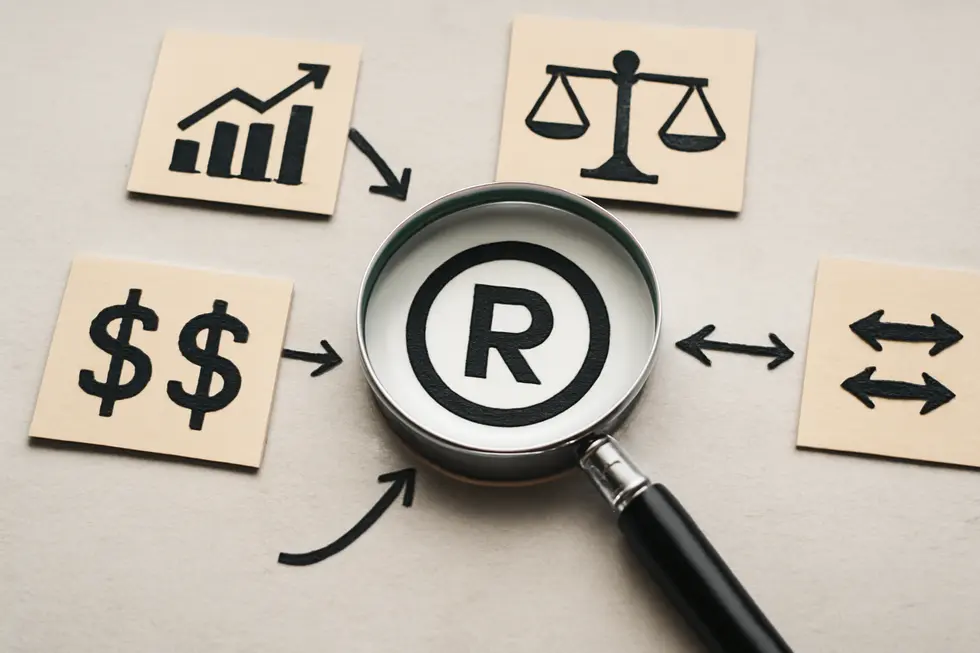Introduction
A trademark stands as a vital business asset, but its value is far from fixed or straightforward. Understanding how much a trademark is worth requires examining various intricate elements, including market presence, legal safeguards, financial returns, and competitive positioning. This exploration uncovers the multifaceted nature of trademark valuation, helping business owners grasp how these intangible marks translate into concrete business advantages. Each chapter reveals a critical aspect of valuation—beginning with the fundamental factors shaping value, followed by the legal frameworks that govern protection and influence worth. We then delve into the revenue and market forces that trademarks command, examine their strategic role amid competition, and explain accounting methods that bring clarity to valuation. Together, these perspectives build a comprehensive understanding essential for maximizing and protecting the true value of your trademark.
Tables of Contents
Chapter 1: Factors Influencing How Much a Trademark Is Worth
- The Crucial Role of Legal Protection and Market Presence in Valuing Trademarks
- How Brand Recognition, Revenue Impact, and Business Dynamics Define Trademark Value
Chapter 2: Legal Considerations in Determining How Much a Trademark Is Worth
- How Legal Protection and Enforceability Shape Trademark Value
- How Goodwill and Market Recognition Shape Legal Valuation of Trademarks
Chapter 3: Revenue and Market Impact on How Much a Trademark Is Worth
- Evaluating Trademark Value Through Income Generation and Market-Driven Valuation Techniques
- The Interplay of Brand Strength, Market Recognition, and Competitive Dynamics in Driving Trademark Value
Chapter 4: Strategic and Competitive Influences on Trademark Valuation
- Balancing Market Dominance and Legal Strength: Key Competitive Drivers of Trademark Value
- Integrating Strategic Value and Valuation Techniques in Trademark Worth
Chapter 5: Accounting and Valuation Methods for How Much a Trademark Is Worth
- Navigating Cost and Market Approaches to Trademark Valuation in Accounting
- Unveiling True Value: Income-Based Valuation and Accounting Treatment of Trademarks
Chapter 1: Factors Influencing How Much a Trademark Is Worth

1. The Crucial Role of Legal Protection and Market Presence in Valuing Trademarks
The worth of a trademark hinges essentially on two intertwined dimensions: the legal protection framework securing its exclusive use and the market presence that defines its commercial strength. These foundational pillars collectively shape a trademark’s value, balancing enforceable rights with economic influence.
Legally, a trademark’s value depends greatly on its registration status and the scope of its protection. Registered trademarks enjoy broader legal safeguards that exclude others from unauthorized use within defined product or service classes, offering a competitive edge through exclusivity. The enforceability of these rights allows trademark owners to defend against infringement, preserving brand identity from dilution or misuse. Litigation involving trademarks can be costly—ranging from $120,000 to $750,000—and carries risks that might reduce the trademark’s market value by around 5%. Proactive legal management, including timely renewals and monitoring, thus plays a vital role in sustaining and enhancing value by mitigating infringement threats and maintaining clear ownership.
Simultaneously, market determinants influence a trademark’s financial and strategic worth. Strong brand recognition fosters consumer trust and loyalty, driving revenue streams directly or through licensing arrangements. A trademark that commands loyalty can shield a business from competitive pressures and generate premium pricing. Its ability to generate consistent income—whether from product sales or royalties—factors heavily in valuation models. Market-based approaches compare comparable trademark transactions to establish value, while income-based models focus on forecasted economic benefits attributable to the trademark’s ongoing performance.
The dynamic interplay between these legal safeguards and market forces is pivotal. Without enforceable rights, even a well-known trademark risks infringement dilution, which undercuts its commercial value. Conversely, legal protection alone cannot create value without meaningful consumer demand and market relevance. Together, they form the backbone for assessing a trademark’s worth, capturing not only its role as an intellectual property asset but also as a driver of business strength and future earnings.
For businesses seeking to deepen their understanding of trademark rights and protections, exploring detailed resources like the comprehensive guidance on trademark protection for business names and logos can offer essential insights.
An authoritative overview of these factors and their impact on valuation can be found in specialized analyses such as those available from PatentPC and Harper James blogs, which detail legal and financial considerations crucial to trademark worth.
2. How Brand Recognition, Revenue Impact, and Business Dynamics Define Trademark Value
The worth of a trademark extends far beyond its visual identity, deeply rooted in the strength of its brand recognition, the financial benefits it generates, and the broader business context that supports it. A trademark with high brand recognition signals established consumer trust, loyalty, and positive goodwill, positioning it as a powerful asset. Such a trademark enhances overall business equity by acting as a symbol of quality and reliability, which can attract investors and buyers. This recognition also helps the trademark stand out in competitive markets, offering resilience against shifting consumer preferences or crises, thus increasing its intrinsic value.
Financially, trademarks drive value through multiple revenue channels. They directly affect sales by fostering customer loyalty, encouraging repeat purchases, and reinforcing premium pricing power. Beyond direct sales, trademarks enable businesses to expand via licensing or franchising, creating streams of royalty income without the operational burdens of entering new markets. In fact, a robust trademark portfolio can unlock significant global opportunities, as it permits monetization of brand equity through strategic partnerships or even the sale of non-core marks. This diverse revenue potential anchors the trademark’s valuation firmly in its capacity to generate ongoing, measurable income.
However, revenue generation is only one aspect of a trademark’s value, which is also shaped by the wider business context. Factors such as industry leadership and competitive positioning influence how much a trademark contributes to market success. A trademark linked to a company with a diverse, stable customer base and adaptable product offerings often commands a higher valuation. Additionally, the legal standing and remaining term of the trademark’s protection are crucial, as uninterrupted enforcement rights preserve exclusive use and deter infringement risks. Corporate reputation tied to the trademark further affects investor confidence and market perceptions, amplifying the intangible asset’s strength.
This interplay of brand strength, reliable revenue streams, and strategic business factors forms the foundation for comprehensive valuation. Businesses looking to appraise their trademarks should consider these dimensions collectively rather than in isolation. For a deeper understanding of trademark enforcement and protection’s role in value, resources like trademark protection for your business name or logo offer essential insights.
External factors constantly evolve, but a trademark that consistently supports sustained revenue within a robust business framework, backed by strong legal safeguards, will inevitably hold greater worth in the marketplace.
Chapter 2: Legal Considerations in Determining How Much a Trademark Is Worth

1. How Legal Protection and Enforceability Shape Trademark Value
Legal protection and enforceability are fundamental to assessing the worth of a trademark. A trademark’s value significantly increases when it is clearly defined, uniquely identifiable, and properly registered, lending it strong legal footing. Registration provides owners with essential rights to prevent unauthorized use and to take legal action against infringers, safeguarding the brand’s exclusivity and market position.
The geographic scope and product categories covered by registration deepen this protection. Trademarks registered across multiple jurisdictions command higher valuations due to broader enforceability. Conversely, trademarks with narrow or nonexistent registrations carry amplified risks of infringement and reduced market protection, which detracts from their overall worth.
An equally important consideration is the duration and maintenance of the trademark. Since trademark registration typically lasts ten years and requires timely renewal, the remaining lifespan of the registration directly impacts valuation. A trademark nearing expiration or one that has lapsed loses critical legal guardrails, thereby diminishing its market value and attractiveness to investors or buyers.
Strong enforceability hinges on unequivocal ownership evidence, validity of registration, and the absence of conflicting prior rights. These factors assure that the trademark can be effectively defended in disputes or opposition proceedings. Weak enforceability or encumbrances from legal challenges elevate risks of invalidation or costly litigations, consequently lowering the trademark’s valuation.
Risks of dilution or infringement further influence value. Legal protections that prevent dilution—where a famous mark’s distinctiveness is weakened—and guard against infringement protect the brand’s reputation and consumer trust. This protection underpins the trademark’s ability to maintain its goodwill and the revenue streams it supports.
While the trademark’s legal status is crucial, it ultimately supports the broader brand recognition and loyalty that generate income. Strong legal enforceability preserves this goodwill by mitigating unauthorized use that could erode consumer confidence.
From an investor perspective, thorough intellectual property audits are vital. Evaluators scrutinize registration completeness, maintenance of legal rights, and freedom from disputes to gauge competitive advantages and liabilities tied to a trademark. These insights inform fair market valuations and highlight legal strengths or vulnerabilities.
For a detailed exploration of the legal protection elements critical to trademark valuation, see this comprehensive guide on trademark accounting and valuation.
Additionally, understanding the nuances of trademark registration and protection can be enriched by resources on how to secure and defend your brand effectively, such as those offered on trademark protection for business names and logos.
2. How Goodwill and Market Recognition Shape Legal Valuation of Trademarks
Goodwill and market recognition are pivotal in the legal evaluation of trademark worth, acting as intertwined drivers that extend far beyond mere registration. Goodwill represents the intangible value emerging from a brand’s reputation, customer loyalty, and the market position its trademark supports. Unlike tangible assets, goodwill is not created internally or independently but is often realized and quantified in acquisition scenarios. When a company purchase price exceeds the measurable value of identifiable assets, that excess is attributed primarily to goodwill. This premium reflects the established consumer trust, effective brand presence, and synergy potential that the trademark and associated business generate together.
Market recognition is equally essential, as it captures the degree of consumer awareness and preference for a trademark. A highly recognized trademark carries substantial legal weight, often commanding enhanced protections against infringement and dilution. The strength of this recognition influences how courts and valuators assess the trademark’s economic contribution because strong market presence directly correlates with increased sales, licensing income, and reduced promotional costs. Recognizable trademarks reduce customer acquisition friction, thereby increasing the brand’s earning potential and ultimately its valuation.
From a legal standpoint, trademarks with proven market recognition also enjoy fortified enforcement rights. Courts tend to grant broader remedies and more vigorous protection for trademarks that have achieved widespread consumer familiarity. This protection, in turn, preserves market exclusivity and sustains the asset’s value over time. Furthermore, the expected remaining duration of legal protection—including renewal status and any risk of abandonment—plays a crucial role in valuation, since an unmaintained trademark quickly diminishes in worth.
Valuation experts carefully weigh these elements alongside financial impacts, such as revenue directly attributable to the trademark. The competitive landscape is also considered, assessing risks like brand dilution or consumer confusion that might detract from value. When trademarks are part of mergers or acquisitions, the goodwill allocation tied to their market recognition affects both negotiation outcomes and subsequent accounting measures, making this interplay vital to understanding trademark worth in legal contexts.
For a deeper exploration of how trademark recognition and legal accounting intersect, see the comprehensive discussion at UpCounsel on trademark accounting and valuation.
Chapter 3: Revenue and Market Impact on How Much a Trademark Is Worth

1. Evaluating Trademark Value Through Income Generation and Market-Driven Valuation Techniques
The value of a trademark is inherently tied to its ability to generate consistent income streams and reflect market realities. Central to this evaluation is the income-based valuation method, which estimates the trademark’s worth by projecting all future revenue directly linked to it. This encompasses royalties earned through licensing agreements, incremental sales attributable to brand recognition, and cost savings generated by reduced marketing expenses. These projected earnings are then discounted to present value, which accounts for risk factors and the time value of money, providing a realistic economic assessment of the trademark’s future financial contributions.
Such an income-focused approach is particularly effective when the trademark is actively used in commerce, supported by measurable revenues or well-founded forecasts. This method underscores how trademarks do more than symbolize identity—they actively drive sales, command premium pricing, and foster customer loyalty that translates into tangible monetary benefit. For mature brands with established market presence, this valuation approach reveals the true economic benefit derived from long-standing brand equity.
Alongside income-based valuation, the market approach offers a perspective anchored in comparables. By examining sales or licensing transactions of similar intellectual property, valuators infer trademark value through existing market activity. However, the method’s practical application is limited by the scarcity and confidentiality of comparable market data, which can obscure transparency.
The cost approach, though less commonly employed, estimates value based on the expense required to recreate or replace a trademark asset. This includes considerations like branding expenditures and legal registration costs, but it typically undervalues a trademark’s growth potential and market influence since it ignores future income opportunities.
A trademark’s market impact plays a decisive role in augmenting its valuation. High visibility and strong consumer loyalty enable the brand to reduce customer acquisition costs and strengthen pricing power. Diverse and resilient income streams—such as endorsements or product line extensions under the mark—further stabilize and enhance overall value. Additionally, robust intellectual property protections grant exclusivity, shielding the brand from competitors and safeguarding long-term revenue potential.
This integrated view of income generation paired with market dynamics ensures a comprehensive understanding of a trademark’s worth, going beyond legal rights to capture economic reality. For businesses aiming to quantify this intangible asset accurately, familiarity with these valuation frameworks is indispensable.
For more detailed insight on intellectual property evaluation, see Actuate IP’s guide on valuing intellectual property. For guidance on trademark protections relevant to enhancing market value, explore this resource on trademark protection for business names and logos.
2. The Interplay of Brand Strength, Market Recognition, and Competitive Dynamics in Driving Trademark Value
A trademark’s value is deeply intertwined with the strength of its brand, the extent of its market recognition, and the nuances of its competitive environment. These elements collectively determine how effectively a trademark can influence consumer behavior, generate income, and sustain its market position over time.
A strong brand signifies more than just a logo or name; it embodies a reservoir of consumer trust, loyalty, and emotional resonance. This intangible asset enables companies to command premium prices and secure enduring customer relationships. The higher the level of brand recognition, the greater the likelihood that consumers will choose that brand over alternatives, raising sales conversion rates and enhancing lifetime customer value. In legal or transactional contexts, tangible evidence of fame, such as consumer surveys or market studies, can substantiate a trademark’s elevated status, directly influencing its valuation.
Revenue impact sits at the heart of this valuation process. A trademark that directly contributes to substantial product sales or licensing income inherently holds higher worth. This financial influence extends to recurring revenue streams and the ability to maintain pricing power within a market. Thus, the trademark becomes not only a symbol of business identity but a key driver of economic performance.
Meanwhile, the competitive environment shapes how trademark value is perceived and preserved. Markets crowded with similar or overlapping brands may dilute a trademark’s exclusivity, lowering its potential to dominate or differentiate. At the same time, robust legal protections help maintain distinctiveness, protecting brand equity from infringement or imitation. The risk of dilution or confusion created by competitors can decrease a trademark’s value, underscoring the strategic importance of ongoing brand management and legal vigilance.
Besides these, the residual term of legal protection underpins a trademark’s market worth. Each renewal extends the period during which a trademark remains an enforceable, exclusive asset, reinforcing its capacity to generate revenue. Furthermore, in mergers and acquisitions, trademarks often convert into goodwill—reflecting their strategic and long-term financial significance beyond mere legal ownership.
This dynamic and multifaceted interplay highlights why trademark valuation extends beyond simple cost or accounting calculations. It demands a nuanced understanding of market perceptions, consumer behavior, legal frameworks, and competitive forces. Such comprehensive insight ensures valuation reflects both current accomplishments and future monetization possibilities.
For further insight into maintaining and protecting your brand’s legal foundation, explore detailed resources on trademark protection for business name and logo.
Source: UpCounsel – Trademark Accounting
Chapter 4: Strategic and Competitive Influences on Trademark Valuation

1. Balancing Market Dominance and Legal Strength: Key Competitive Drivers of Trademark Value
The value of a trademark is deeply intertwined with how well it stands out in a competitive marketplace and the robustness of its legal protections. Market dominance stems from a trademark’s ability to create a distinct identity that connects uniquely with its audience. When a trademark sharply differentiates a brand, it fosters strong consumer preference and loyalty, which sustains premium pricing and steady revenue. This positioning comes from a clear understanding of customer needs, diligent competitive analysis, and a compelling value proposition that resonates long-term. Trademarks that have successfully cultivated trust and recognition effectively leverage that market power to amplify their worth.
Yet, market position alone cannot guarantee lasting value without solid legal defensibility. The protection a trademark enjoys under intellectual property law directly governs its exclusivity and enforceability. A distinct and identifiable trademark that can be vigorously defended against infringement or opposition reduces the risk of dilution or loss. Legal defensibility is bolstered by documented prior use, consistent branding efforts, and clear evidence of preventing consumer confusion, all of which solidify the trademark owner’s rights. These legal protections are crucial for maintaining exclusivity in the face of competitive challenges and for sustaining elevated valuation multiples.
Together, these two pillars—market position and legal strength—shape the trademark’s financial prospects. A trademark commanding customer loyalty and market share while being firmly backed by enforceable rights creates more predictable revenue and licensing opportunities. This reduces risk and enhances appeal to investors and acquirers. Conversely, trademarks vulnerable to legal disputes or lacking meaningful differentiation command less value due to uncertain future benefits.
Assessing these dimensions reveals why valuation experts emphasize both commercial success and legal stability. The dual focus ensures trademarks are appraised as intangible assets with real-world competitive advantage and protection. For business owners and investors alike, understanding the balance between market dominance and legal enforceability is essential to grasp how much a trademark is truly worth.
For further insights on protecting your mark, explore trademark protection for business names and logos. To deepen understanding of legal defensibility, see How to Gather Strong Evidence for Trademark Opposition Proceedings.
2. Integrating Strategic Value and Valuation Techniques in Trademark Worth
Determining the true worth of a trademark requires more than just legal registration details or market presence; it demands a strategic perspective that integrates the trademark’s role in business operations with rigorous valuation methods. At its core, the value of a trademark is shaped by its ability to generate consumer trust and loyalty, ultimately translating into revenue streams and competitive advantage that influence business success.
A trademark’s market recognition and brand strength serve as a foundation for its premium value. Well-known marks reduce marketing expenses by anchoring customer loyalty and enhancing product differentiation. In mergers and acquisitions, these marks often translate into goodwill—an intangible asset that reflects expected future benefits arising from the asset’s integration. The remaining legal life of a trademark further shapes its value, as trademarks are protected in 10-year increments that require renewal to maintain enforceability. Without renewal, the brand loses legal protection, eroding its strategic value.
Financially, the trademark’s direct impact on revenue—whether through sales uplift, licensing income, or cost savings—forms the basis for its valuation. Assessing this impact within the dynamic competitive environment is critical. Trademarks that successfully fend off infringement, minimize consumer confusion, and occupy a unique market position command greater worth. Conversely, risk factors such as potential dilution or legal disputes reduce the appeal and valuation of a mark.
When selecting valuation methodologies, a strategic lens guides the choice between cost, market, and income approaches. The cost approach accounts for expenses involved in creating or replacing the trademark but often undervalues the asset by ignoring its earning potential. The market approach, relying on comparable trademark transactions, provides external benchmarks but may falter due to limited deal data.
The income approach, particularly the relief-from-royalty method, best captures a trademark’s strategic value. By estimating the hypothetical royalties saved due to owning the trademark, this method reflects the economic advantages from brand-driven pricing power and consumer loyalty. Its alignment with business integration scenarios makes it invaluable for investment decisions, allowing companies to quantify the intangible benefits trademarks bring to their competitive stance.
Ultimately, determining how much a trademark is worth demands harmonizing strategic business insights with appropriate valuation techniques. Aligning the valuation method with the trademark’s specific role within the company and its market environment ensures a more accurate and defensible assessment. This approach empowers businesses to leverage their trademarks effectively as key assets in long-term growth, acquisition negotiations, and brand management.
For additional insights on protecting business identity, see the detailed discussion on trademark protection for business names and logos.
For a deeper understanding of valuation methods and strategic IP management, consult the comprehensive analyses available at PatentPC.
Chapter 5: Accounting and Valuation Methods for How Much a Trademark Is Worth

1. Navigating Cost and Market Approaches to Trademark Valuation in Accounting
Determining the value of a trademark within accounting and valuation frameworks often relies on two pivotal methods: the Cost Approach and the Market Approach. These approaches, while distinct in rationale and application, provide complementary lenses to assess a trademark’s worth, especially in contexts where other valuation angles might be limited or unavailable.
The Cost Approach hinges on quantifying the actual and historic expenses incurred to create or replace a trademark. This includes all direct expenditures such as research, design activities, and legal fees associated with registration and protection. It serves well for newly established trademarks or when market data is scarce, offering a grounded, tangible estimate based on documented outlays. However, this method does not account for the trademark’s capacity to generate future income or its market reputation. As a result, the valuation derived may understate or overstate the trademark’s true worth, especially if brand recognition or consumer loyalty surpasses mere replacement costs.
By contrast, the Market Approach assesses a trademark’s value by examining recent sales or licensing transactions involving comparable trademarks. This method reflects market participants’ real-time willingness to pay and provides a practical benchmark when an active marketplace with relevant comparables exists. Despite its appeal, the Market Approach’s effectiveness is often constrained by the availability of truly analogous trademarks or transparent transaction data. Unique attributes of some trademarks might defy direct comparison, limiting the applicability of pure market-based valuation.
From an accounting perspective, trademarks are classified as indefinite-lived assets since they can generally be renewed indefinitely, often in 10-year increments. Consequently, they are not amortized systematically. Instead, annual impairment reviews are conducted to ensure their recorded value remains accurate and justified. Only capitalizable expenses, such as registration and legal fees, are included on the balance sheet. Expenses related to marketing or promotion, though critical to building brand equity, are recognized as period costs and do not increase the trademark’s book value.
In practice, these approaches are most effective when integrated with an Income Approach, which forecasts and discounts future earnings attributable to the trademark’s influence. This comprehensive strategy offers a holistic view of value that combines tangible costs, market realities, and financial performance potential. Such rigor supports more informed financial reporting and strategic decision-making.
For further insights into intellectual property valuation and protection, exploring the guidance on trademark protection for business names and logos can provide valuable context. Additionally, expert frameworks like those from Actuate IP offer a structured understanding of IP valuation methodologies and principles.
2. Unveiling True Value: Income-Based Valuation and Accounting Treatment of Trademarks
Determining the worth of a trademark through income-based valuation involves analyzing the economic benefits it is expected to generate over time. This approach estimates the present value of future income streams directly attributable to the trademark, such as licensing revenues, royalty income, and increased sales driven by brand recognition and customer loyalty. By forecasting these cash flows and discounting them using a rate that reflects risks and the time value of money, the income-based method translates intangible brand strength into tangible financial figures.
Such valuation is particularly effective for trademarks with reliable historical income or solid projections demonstrating their ongoing capacity to generate returns. It captures the core economic contribution of the trademark beyond mere legal ownership, spotlighting how the brand influences revenue generation. This makes it especially relevant in accounting and financial reporting, where asset valuation must mirror real economic potential.
From an accounting perspective, trademarks valued under this method are recorded on the balance sheet as intangible assets at their fair value. They are typically amortized over their useful lives, reflecting consumption of economic benefits over time. When circumstances suggest a decline in value, impairment testing ensures the carrying amount does not exceed recoverable amounts, protecting financial statements from inflated valuations. The income-based approach thus aligns well with accounting standards focused on fair value measurement and asset recoverability.
While powerful on its own, the income method is often integrated with other valuation approaches—the market method, which examines comparable trademark transactions, and the cost method, estimating costs to recreate the trademark. Additionally, frameworks like the OECD’s DEMPE (Development, Enhancement, Maintenance, Protection, and Exploitation) provide important guidance in attributing economic control and benefits, which is critical in contexts like transfer pricing and royalty determinations.
This comprehensive valuation and accounting framework ensures that trademarks are not merely legal constructs but recognized as strategic assets with measurable financial significance. Accurate income-based valuation promotes transparent financial reporting and compliance, illuminating the real business value embedded in a trademark’s enduring consumer impact.
For further insights on intangible asset valuation frameworks, see Brand and IP Valuation: Economic Control vs Legal Title — BCAJ Online.
Moreover, understanding trademark protection’s influence on brand value is essential and can be explored in depth at trademark protection for business name and logo.
Final thoughts
The worth of a trademark is a complex and dynamic metric that extends beyond mere registration. By understanding the interplay of market recognition, legal protections, revenue impact, and competitive strategies, business owners can better appreciate their trademark’s true value and leverage it strategically. Moreover, accurate valuation depends on expert insight and appropriate accounting practices tailored to the brand’s specific circumstances. Ultimately, treating your trademark as a priceless intangible asset ensures it contributes meaningfully to your business success and long-term growth.
Your IP is the foundation of your success – let’s protect it together before it’s too late. We can’t wait to help you turn your ideas into legally secured assets.
About us
undefined


